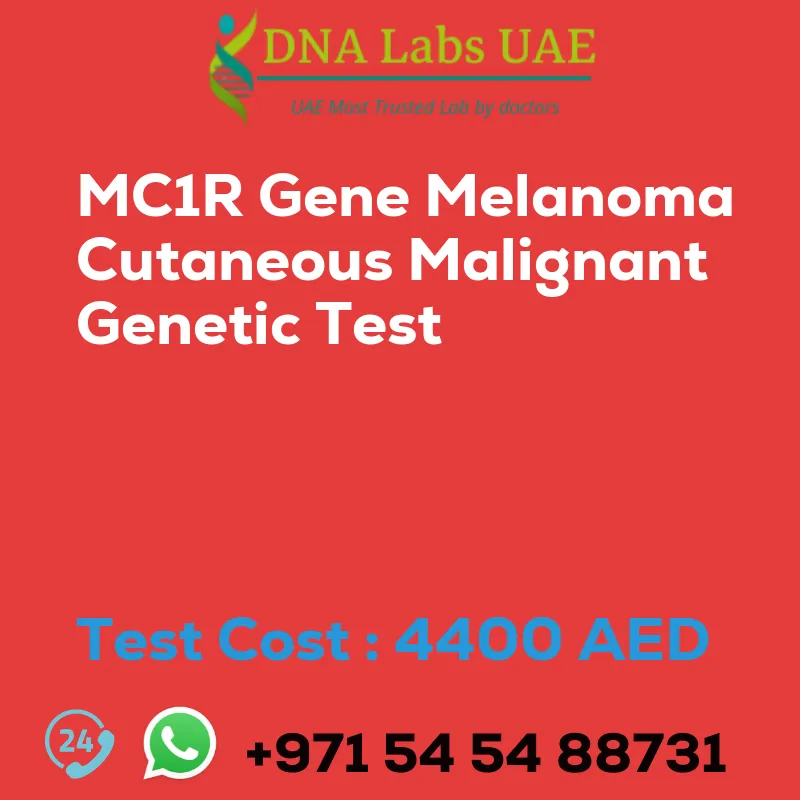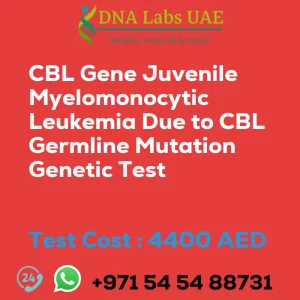MC1R Gene Melanoma cutaneous malignant Genetic Test
Test Name: MC1R Gene Melanoma cutaneous malignant Genetic Test
Components: Blood or Extracted DNA or One drop Blood on FTA Card
Price: 4400.0 AED
Report Delivery: 3 to 4 Weeks
Method: NGS Technology
Test Type: Cancer
Doctor: Oncologist
Test Department: Genetics
Pre Test Information: Clinical History of Patient who is going for MC1R Gene Melanoma, cutaneous malignant NGS Genetic DNA Test. A Genetic Counselling session to draw a pedigree chart of family members affected with MC1R Gene Melanoma, cutaneous malignant NGS Genetic DNA Test gene MC1R
Test Details
The MC1R gene is a gene that codes for a protein called melanocortin 1 receptor, which plays a crucial role in the production of melanin, the pigment responsible for determining hair, skin, and eye color. Variations in the MC1R gene can affect the production and function of melanin, leading to different hair and skin color phenotypes.
Melanoma is a type of skin cancer that occurs when melanocytes, the cells responsible for producing melanin, become cancerous. Mutations in the MC1R gene have been associated with an increased risk of developing melanoma, particularly in individuals with fair skin and red hair.
NGS (Next-Generation Sequencing) is a high-throughput DNA sequencing technology that allows for the simultaneous sequencing of millions of DNA fragments. NGS genetic testing involves analyzing the DNA sequence of specific genes, such as the MC1R gene, to identify any variations or mutations that may be associated with certain diseases or conditions.
In the case of cutaneous malignant NGS genetic testing, the MC1R gene would be sequenced to identify any mutations or variations that may increase an individual’s risk of developing cutaneous malignant melanoma, a specific type of melanoma that affects the skin.
By identifying these genetic variations, individuals at a higher risk of developing melanoma can be identified and appropriate preventive measures, such as regular skin examinations and sun protection, can be recommended. Additionally, this information can also be useful for genetic counseling and informing family members about their potential risk for melanoma.
| Test Name | MC1R Gene Melanoma cutaneous malignant Genetic Test |
|---|---|
| Components | |
| Price | 4400.0 AED |
| Sample Condition | Blood or Extracted DNA or One drop Blood on FTA Card |
| Report Delivery | 3 to 4 Weeks |
| Method | NGS Technology |
| Test type | Cancer |
| Doctor | Oncologist |
| Test Department: | Genetics |
| Pre Test Information | Clinical History of Patient who is going for MC1R Gene Melanoma, cutaneous malignant NGS Genetic DNA Test. A Genetic Counselling session to draw a pedigree chart of family members affected with MC1R Gene Melanoma, cutaneous malignant NGS Genetic DNA Test gene MC1R |
| Test Details |
The MC1R gene is a gene that codes for a protein called melanocortin 1 receptor, which plays a crucial role in the production of melanin, the pigment responsible for determining hair, skin, and eye color. Variations in the MC1R gene can affect the production and function of melanin, leading to different hair and skin color phenotypes. Melanoma is a type of skin cancer that occurs when melanocytes, the cells responsible for producing melanin, become cancerous. Mutations in the MC1R gene have been associated with an increased risk of developing melanoma, particularly in individuals with fair skin and red hair. NGS (Next-Generation Sequencing) is a high-throughput DNA sequencing technology that allows for the simultaneous sequencing of millions of DNA fragments. NGS genetic testing involves analyzing the DNA sequence of specific genes, such as the MC1R gene, to identify any variations or mutations that may be associated with certain diseases or conditions. In the case of cutaneous malignant NGS genetic testing, the MC1R gene would be sequenced to identify any mutations or variations that may increase an individual’s risk of developing cutaneous malignant melanoma, a specific type of melanoma that affects the skin. By identifying these genetic variations, individuals at a higher risk of developing melanoma can be identified and appropriate preventive measures, such as regular skin examinations and sun protection, can be recommended. Additionally, this information can also be useful for genetic counseling and informing family members about their potential risk for melanoma. |








